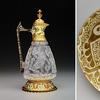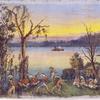Abstract Expressionist William Pachner Exhibition at Mindy Solomon Gallery
- MIAMI, Florida
- /
- January 20, 2015
2015 marks the 100th year of life for painter William Pachner—a journey that can be measured in concert with the chronology of his work. Wholly authentic in his visual musings, his trajectory follows the pattern of 20th century stylistic milestones, while retaining the fluidity and expressiveness of Pachner’s own unique artistry. His Abstract Expressionist drawings and paintings are a visual feast, embodying swirling colors and texture, while his deeply layered surfaces speak to a much deeper world concern.
Miami's Mindy Solomon Gallery will present WILLIAM PACHNER: Selected Works from the 60s, 70s, and 80s, January 29th-February 25th, 2015, with an Opening Reception Thursday, February 5th from 6-9pm during Wynwood Collectors' Preview.
Born in Czechoslovakia, William Pachner studied in Vienna before coming to the United States in 1939 on the eve of World War II, where his anti-fascist illustrations appeared in top national magazines. When he learned in 1945 that every member of his family had been slaughtered in Germany, he left his commercial career and turned to Abstract Expressionism as an outlet for his emotions. Recognized for exceptional color intensity, Pachner’s works often depict erotic and biblical themes. After losing his eyesight and becoming blind later in his career, Pachner also created extensively in black and white. His drawings and paintings contain a paradox of meanings: the form, movement, and gesture affirm vitality, yet they are tinged with horror and violence. Loss and absence—of sight, family, and homeland, alongside the personal and artistic annihilation Pachner has faced—are represented in various configurations unique to each composition.
Lawrence Dame of the Palm Beach Post described Pachner’s technique as “...brushwork...in the grand manner, showing a knowledge of the kind of immortal art that somewhat recalls the chiaroscuro masterworks of Rembrandt. The muting of subject matter, which is not totally submerged as in many pieces, is fraught with feeling, making the spectator wonder and want to know more instead of turning away in puzzlement or disgust.”
Unlike the pure abstraction of the New York school, Pachner’s Expressionism has always employed figuration, sensuality, intense emotion and a protean variety of approaches to composition and paint. He states: “I want my art to reflect our human experience in the world in its totality, the beautiful as well as the atrocious, the tender and caring as well as the insensitive and murderous...The celebration and affirmation of the beauty of creation must coexist not alternately but simultaneously with the tragic.” While some paintings and drawings may appear delicate, wistful in the application of light and color, others are very dark with the colors mixed in a kind of brown/black abyss, fighting to retain pigmentation and intensity—perhaps a metaphor for the challenges of a survivor struggling to understand his ability to live and enjoy while others were not afforded the same.
"Pachner’s first paintings were illustrative, but he soon recognized their limitations and embarked on a study of the old masters. First the Flemish fifteenth-century paintings captivated him, then Rembrant and Goya. From Cezanne and Picasso he learned modern concepts of form, in Redon, Bonnard, Chagall and Roualt he saw how color could be used expressively...Crucifixion, motherhood, and the embrace,” wrote critic Wallace F. Green. "He saw these not as specific incidents, but as universal expressions of the deepest human emotions...Pachner’s work was characterized by a monumental quality of human dignity. There was compassion for tragedies of martyrdom and loneliness, sensitivity to the erotic quality of love.”
By the 1980s, Pachner’s landscapes had begun to transition. Robert Martin, former art critic for the Tampa Times, has written: "These landscapes have a quality of 'slowly growing even as we look at them' because one experiences them in real time, and not all in one glance. Their beauty and meaning reveal themselves slowly. In the process, these paintings actively encourage us to explore our own values, our own real feelings, and what it means to be a member of the family of man— all of which are rare qualities in the art of any era.”
The works on view at Mindy Solomon Gallery will be a sampling of these important years in William Pachner’s remarkable life.

100x100_n.jpg)
100x100_c.jpg)













